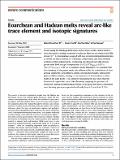Files in this item
Eoarchean and Hadean melts reveal arc-like trace element and isotopic signatures
Item metadata
| dc.contributor.author | Chowdhury, Wriju | |
| dc.contributor.author | Trail, Dustin | |
| dc.contributor.author | Miller, Martha | |
| dc.contributor.author | Savage, Paul | |
| dc.date.accessioned | 2023-03-06T12:30:10Z | |
| dc.date.available | 2023-03-06T12:30:10Z | |
| dc.date.issued | 2023-02-28 | |
| dc.identifier | 283628207 | |
| dc.identifier | 45619f45-8352-4a49-986b-d0e5396bf337 | |
| dc.identifier | 85149105657 | |
| dc.identifier.citation | Chowdhury , W , Trail , D , Miller , M & Savage , P 2023 , ' Eoarchean and Hadean melts reveal arc-like trace element and isotopic signatures ' , Nature Communications , vol. 14 , 1140 . https://doi.org/10.1038/s41467-023-36538-5 | en |
| dc.identifier.issn | 2041-1723 | |
| dc.identifier.other | Jisc: 929250 | |
| dc.identifier.other | publisher-id: s41467-023-36538-5 | |
| dc.identifier.other | manuscript: 36538 | |
| dc.identifier.other | ORCID: /0000-0001-8464-0264/work/130659970 | |
| dc.identifier.uri | https://hdl.handle.net/10023/27107 | |
| dc.description | Funding: This work was supported by NSF EAR-1650033 (DT), NSF EAR-1751903 (DT) and NASA PC3 grant 80NSSC19M0069 (DT). | en |
| dc.description.abstract | Constraining the lithological diversity and tectonics of the earliest Earth is critical to understanding our planet’s evolution. Here we use detrital Jack Hills zircon (3.7 − 4.2 Ga) analyses coupled with new experimental partitioning data to model the silica content, Si+O isotopic composition, and trace element contents of their parent melts. Comparing our derived Jack Hills zircons’ parent melt Si+O isotopic compositions (−1.92 ≤ δ30SiNBS28 ≤ 0.53 ‰; 5.23 ≤ δ18OVSMOW ≤ 9.00 ‰) to younger crustal lithologies, we conclude that the chemistry of the parent melts was influenced by the assimilation of terrigenous sediments, serpentinites, cherts, and silicified basalts, followed by igneous differentiation, leading to the formation of intermediate to felsic melts in the early Earth. Trace element measurements also show that the formational regime had an arc-like chemistry, implying the presence of mobile-lid tectonics in the Hadean. Finally, we propose that these continental-crust forming processes operated uniformly from 4.2 to at least 3.7 Ga. | |
| dc.format.extent | 10 | |
| dc.format.extent | 1200333 | |
| dc.language.iso | eng | |
| dc.relation.ispartof | Nature Communications | en |
| dc.subject | QE Geology | en |
| dc.subject | DAS | en |
| dc.subject | MCC | en |
| dc.subject.lcc | QE | en |
| dc.title | Eoarchean and Hadean melts reveal arc-like trace element and isotopic signatures | en |
| dc.type | Journal article | en |
| dc.contributor.institution | University of St Andrews. School of Earth & Environmental Sciences | en |
| dc.contributor.institution | University of St Andrews. St Andrews Centre for Exoplanet Science | en |
| dc.contributor.institution | University of St Andrews. St Andrews Isotope Geochemistry | en |
| dc.identifier.doi | https://doi.org/10.1038/s41467-023-36538-5 | |
| dc.description.status | Peer reviewed | en |
This item appears in the following Collection(s)
Items in the St Andrews Research Repository are protected by copyright, with all rights reserved, unless otherwise indicated.

